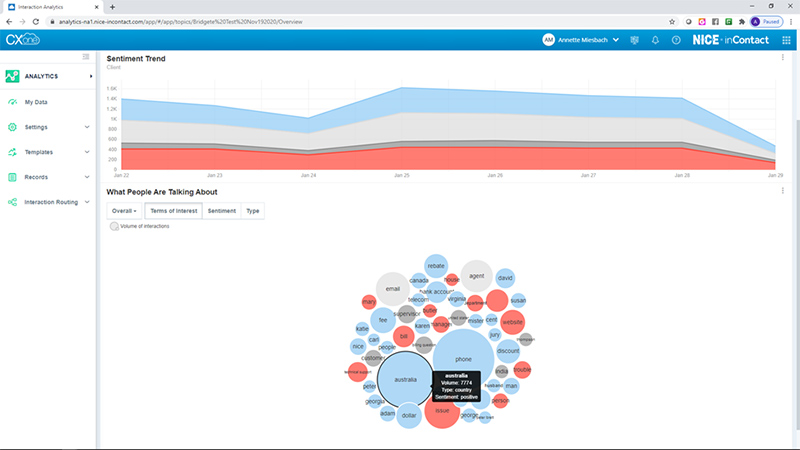Do you ever wish your small call center could leverage artificial intelligence (AI) to provide enhanced customer experiences (CX) and smarter operations? Would the information provided by modern analytics enable you to make better, revenue-impacting decisions?
If it's been a few years since you've looked at call center software, you might be surprised to learn that the AI capabilities and analytics tools previously available only to companies with deep pockets are now much more affordable. These advanced call center technologies can help small businesses compete head-to-head with larger companies and, ultimately, think big and act bigger.
This is the third article in a four-part series designed to help small call centers choose the right software to enable them to thrive and compete. The first article focused on cloud call center software as a growth enabler, the second was all about building customer loyalty, and now we'll discuss how to use modern technology to compete more effectively and take performance to the next level.
Cloud Call Center Software for Small Business is Within Reach
Being a small business these days is kind of like a case of "good news, bad news." On the one hand, small and medium sized businesses (SMBs) often have to compete head-on with large companies who have more resources for marketing, research, technology, and just about every other factor that supports growth. Additionally, economies of scale enable big organizations to charge lower prices for products and services, while the internet makes it very easy for consumers to comparison shop based on price.
But here's the good news for SMBs - the price has been eclipsed by experience as the primary factor for purchase decisions. In fact, according to Gartner, two out of three businesses now compete primarily on customer experience (CX) and that number is expected to grow. Additionally, our recent consumer research revealed that more than half of consumers are willing to pay more for great CX and 87% are willing to buy more from businesses that provide exceptional experiences. To take full advantage, SMBs need the right tools, such as call center AI and analytics.
But changes in consumer preferences don't end at price vs. CX. People also want choices with how they interact with businesses to include self-service and digital channels like chat, social media, and text (SMS). This can, indeed, be bad news for SMBs who haven't modernized their call centers. Outdated PBX and VoIP solutions commonly found in small call centers are typically not flexible enough to meet current consumer demands.
On the flip side, cloud call center software offers some very good news. The latest features, including integrated phone and digital channels, AI-infused self-service, and sophisticated analytics, are available to small businesses willing to make an incremental investment in the quality of their CX and customer intelligence.
If you're using call center technology that is more than five years old, a replacement is in order, the sooner the better. Why the urgency? If the need to compete on CX and respond to new consumer demands didn't convince you, consider this: 2020. The business disruptions caused by the pandemic are still ongoing and taught us that we need to be agile in order to respond to the unexpected. Cloud-based solutions make businesses more resilient by providing the ability, for example, to quickly set up agents to work remotely or rapidly deploy self-service capabilities to respond to increased customer demand for support.
All of these capabilities enable SMBs to think big and act bigger. Two in particular - analytics and artificial intelligence - can help SMBs compete by making data-driven decisions and providing unique and cost-effective CX. Let's take a closer look at what's available and examine some use cases for small call centers.
Small Business Call Center Analytics
There are several analytics tools that can turn raw call center data into actionable insights. These analytics applications help leaders better understand their customers and operations so they can make timely, informed decisions.
Best Contact Center Metric Tools for Small Business
1. Interaction Analytics
What is Interaction Analytics?
Interaction analytics, also called speech analytics, is probably the most robust and useful of the current call center analytics tools. It leverages artificial intelligence capabilities, such as natural language understanding (NLU), to comb through voice and digital interactions and analyze what is happening in conversations between customers and agents. The ability to perform cross-channel analytics in real-time provides call centers with highly useful and timely insights about call drivers, emerging issues, quality, potential compliance issues, and much more. Additionally, the best interaction analytics software can determine customer sentiment, which can be aggregated at the call center and individual agent levels and allow end-users to drill down to individual customer scores. Interaction analytics facilitates better problem management and provides a more comprehensive voice of the customer.
Small Business Interaction Analytics Use Case
Your call volume is typically steady and predictable, but one day the number of calls goes through the roof. Agents don't have time to discuss what's driving the volume because they're busy handling back-to-back calls. Fortunately, you have interaction analytics, which identifies a bug with your new software release as the top call driver. This allows you to quickly notify the developers, put an upfront message on your IVR, and send an explanatory and apologetic email to affected customers.
2. Quality Management Analytics
What is Quality Management Analytics?
Quality management analytics has many of the same capabilities as interaction analytics, but it's used specifically for quality monitoring. This analytics tool can use NLU to pinpoint specific interactions that should be evaluated (based on keywords or customer sentiment) and either score the interaction or flag it for a supervisor or analyst to review. Quality management analytics can also identify trends and provide leaders with a more holistic and accurate view of call center quality without requiring an army of quality analysts.
Quality Management Analytics Use Case
You've just introduced a new line of hand sanitizers for commercial use and you have trained your agents to use certain language when explaining the product. To ensure agents are complying with this standard, you can have your quality management analytics tool flag all interactions where the key phrase "hand sanitizer" was used. This allows supervisors to know which calls or digital contacts to review and enables them to identify agents who need refresher training. This categorization is also useful when surfacing knowledgebase recommendations to agents in real-time so if they have questions about the hand sanitizer product, the answer is immediately on-hand and auto-suggested.
4 Call Center AI Use Cases for Small Business

Artificial intelligence can make call center processes smarter and enable SMBs to "act bigger" with the types of experiences they can offer their customers. Below are some examples of call center AI that can change the way you do business.
1. AI-Infused Forecasting
What is AI-infused Forecasting?
Having enough agents available to handle volume is a critical element to delivering satisfying CX. Staffing plans and agent schedules are built upon volume forecasts, so those forecasts need to be as accurate as possible. Workforce management (WFM) software that leverages AI can make forecasts more accurate by choosing the best forecasting algorithm for your specific scenario. Your customers will be pleased by the lower queue times.
Example of AI-powered Forecasting
The employee who does call center forecasting just quit unexpectedly and no one is cross-trained to do her job. Fortunately, you use intuitive, industry-leading WFM software that enables her replacement to quickly get up to speed. Better yet, the new forecaster doesn't need to become an expert on forecasting algorithms because the application will recommend the best one.
2. Virtual Agents
What are Virtual Agents?
Chatbots are AI-driven technology that can understand and mimic human speech so they can interact with people. Consumers and businesses agree that chatbots need to get smarter, but they are still good at handling simple transactions and answering common questions. Businesses frequently deploy chatbots on their websites to assist with sales or customer service. Additionally, they can be used in channels like Facebook Messenger. When designed right, chatbots can provide satisfying and cost-effective 24/7 service.
Example Chatbot Use Case for Small Business
Your call center closes at 7 pm, but at 8 pm your customer, Daniel, realizes he needs to reschedule the installation appointment booked for the following afternoon. He visits the "contact us" page of your website where he is greeted by a chatbot that helps Daniel rebook the installation and also answers a question about warranties. The experience leaves Daniel impressed with your company's convenience and use of advanced technology, while your business saves money by automating the interaction and by being able to book the crew for a different afternoon installation.
3. Conversational AI
What is Conversational AI?
We've talked about virtual agent chatbots, now let's talk about what conversational AI can do for voice interactions. Conversational AI understands and speaks human language. When integrated with interactive voice response (IVR) systems, conversational AI can allow callers to say what they need, making it possible to bypass lengthy menus. Additionally, it can assist customers with self-service transactions or help gather caller information that can be passed to agents, leading to lower handle times.
Conversational AI Use Case for Small Business
One of your business customers calls to find out their account balance. When the IVR greets them, it asks them to state the reason for the call. When the customer says, "check account balance," the IVR understands them and then walks them through an authentication process. Once the caller is verified, the IVR queries the accounting system and tells the customer what their balance is. It also asks them if they want to pay their balance and walks them through that process, as well. Conversational AI makes voice self-service a more natural experience and, because it can help improve self-service success rates, it can help control labor costs.
4. Predictive Behavioral Routing
What is Predictive Behavioral Routing?
You may already be doing skills-based routing, in which you match customers to agents based on the nature of the issue and the agents' qualifications. That's a best practice for delivering great CX. But what if you could further personalize routing by factoring in personalities and preferences? Predictive behavioral routing leverages a huge database of consumers' behavioral profiles that include personality types and communication preferences to match them to agents who have had success dealing with this type of consumer. This can drive better results.
Predictive Behavioral Routing Use Case
Your customer Marta contacts you via chat about a delivery issue. According to the profile in the database, Marta likes more formal communications and she wants to get straight to the point without any small talk. So, your omnichannel ACD routes Marta to a chat agent that uses a formal writing style and has low average handle times, indicating he solves problems quickly. Marta is satisfied with the interaction because it met her preferences and solved her issue.
How to Get Started with Advanced Cloud Call Center Technology for Small Business

These analytics and call center AI capabilities can transform the way you operate and deliver CX. Larger companies already use many of these capabilities and it's giving them an advantage, but the advantage is temporary because the technology is now within reach of small call centers.
But with so many options, how should an organization get started? Start small and expand as you learn and experience success. A chatbot is a great place to start.
Steps to Implementing a Small Business AI-enabled Chatbot
1. Figure out what contact types you want the chatbot to handle.
Remember that chatbots work best for simple transactions, like checking order status and account balances or ordering food and booking appointments. They can also answer frequently asked questions. With that in mind, look at your most common contact types and identify ones that are candidates for the chatbot to handle.
2. Design the virtual agent
This is perhaps the most important step because a poorly designed chatbot can cause terrible CX. Design considerations range from the technical - what integrations are needed - to the qualitative - what is your bot's name and personality? For more design tips, read Cheat Sheet for Building the Best Chatbot.
3. Pilot
Since your bot is new to you and your customers, start with a pilot to gage customer reaction and collect results about the effectiveness of the chatbot. Survey your customers to find out what they think about it. Then use the lessons learned to improve the bot.
4. Expand
If the bot is working well at handling a couple of contact types, don't stop there. Determine what other issues and transactions it can handle or consider expanding its reach by adding it to another channel. And don't forget about creating blended experiences where the chatbot collects information and hands it off to an agent to complete the interaction.
Small Business AI Real-Life Example
You've likely heard of retailer DSW but did you know they have successfully used call center AI integrated with NICE CXone to support their impressive growth? When businesses grow, their call centers typically grow, as well, adding cost and complexity. DSW found themselves in this situation but found their growth in call center seats unsustainable.
To better manage the increased service demands, DSW implemented a conversational AI bot in their IVR to perform the caller authentication task previously handled by agents. This lowered the average handle time by two minutes while increasing customer satisfaction. But they didn't end with that - they have plans to use bots to help handle two other contact types.
The DSW story is a great example of how businesses of all sizes can leverage advanced technology to support growth and satisfy customers. To find out more, watch the on-demand webinar CXone Powers DSW’s Transformational Journey to AI-Powered Virtual Agents.
Final Thoughts
When looking for your next call center software solution, don't settle for a "like-for-like" replacement. Think bigger than that. Transformational capabilities, such as analytics and artificial intelligence, are within reach of your small call center and will enable your organization to act bigger and become bigger.
For an idea on what to consider when looking for a new contact center, download this free guide: Choosing a CCaaS for Small and Mid-sized Organizations
You can also check out our product suite and start building your ideal solution today. To get you started, we've put together some suggested packages.





